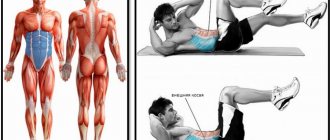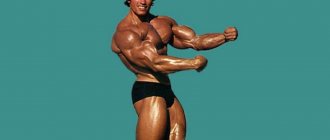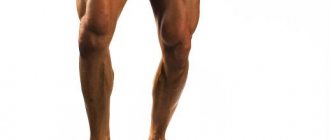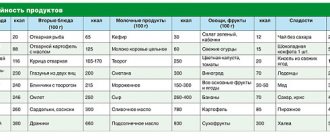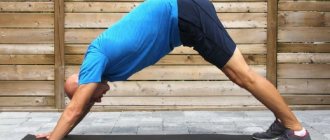How many times a week should you pump your abs?
No figure, especially a sporty one, can do without beautiful biceps.
What is biceps? This is the biceps minor muscle, which is attached to the scapula and to the radius. Thanks to the biceps, the arm lifts, bends, and rotates the hand.
To pump up your biceps. you need to make active movements with your elbow and shoulder joints. It is possible to develop muscles in this area from childhood, in particular by doing pull-ups.
Pull-ups will not only help to stretch the muscles, but at the same time they will develop their width well, which in turn will give the biceps a beautiful rounded shape.
It is important!
But you must not forget the following - you will not gain muscle mass with just one pull-up; there is a special set of exercises for this.
If you are new to this business, but still want to have excellent arm muscles, then ask yourself the following question:
How many times a week should you train your biceps?
In this case, the level of quality is fundamentally important, not quantity, so you shouldn’t get hung up on the number of exercises done. You need to start from the smallest. We will provide you with a couple of exercises, and you, having chosen two from them, start practicing
Take 4-5 minutes for each exercise, which will be 2-3 sets of 8-10 times. It will be enough to study just one day a week. At the end of a high-quality load, the muscles should rest well
We will provide you with a couple of exercises, and you, having chosen two from them, start practicing. Take 4-5 minutes for each exercise, which will be 2-3 sets of 8-10 times. It will be enough to study just one day a week. At the end of a high-quality load, the muscles should rest well
You need to start from the smallest. We will provide you with a couple of exercises, and you, having chosen two from them, start practicing. Take 4-5 minutes for each exercise, which will be 2-3 sets of 8-10 times. It will be enough to study just one day a week. At the end of a high-quality load, the muscles should rest well.
In addition, it is extremely important to select the correct weight of the equipment. It should be appropriate, in other words, not too heavy, but not too light. Slowly go to increase the number of approaches and repetition of work
For example, up to 3-4 sets of 15-20 repetitions
Slowly start increasing the number of approaches and repetition of work. For example, up to 3-4 sets of 15-20 repetitions
In addition, with increasing approaches and repetitions, reduce the weight of the equipment, as this will improve the execution technique, which is very important for the formation of excellent muscles
So, let's move on to the exercises.
Standing barbell lifting exercise
Everyone knows how to do this exercise: feet shoulder-width apart, back slightly arched, jerk the barbell overhead and slowly lower it to the shoulders.
This exercise is great for helping you gain muscle mass by pumping up all the muscles and strengthening the head of the biceps.
Underhand grip, hands shoulder-width apart
Starting position: bar at hip height, legs slightly bent at the knees, back straight. It is necessary to slowly bend your arms, thereby lifting the barbell to your shoulders, while at the same time fixing your elbows on the sides of the body.
After you finish raising your arms, fix this position for 5-6 seconds without relaxing your muscles, then slowly lower your arms.
It is extremely important not to tilt the body or bend the back, since this not only affects the technique, but also puts enormous stress on the spine
Standing Dumbbell Raise
You must lift the dumbbells first with one hand, and then with the other, while keeping your back straight. The other hand may be fixed to the body during rest or lie at the seams.
The peculiarity of this exercise is that with heavy weights it is possible to achieve great results very quickly.
Putting your hand on something stable
We hold a dumbbell in our hand near the thigh, palm facing inward. Slowly raise your hand up, at the same time turning your hand away from you, tensing your muscles as much as possible. In reverse order, return to the starting position.
Scott bench exercise
In this exercise, only the small head of the biceps works, since it is unrealistic to change the initial position of the hand.
Take the dumbbells in your hands and lean on the bench. Slowly bend and straighten your elbow.
Great biceps are what will make your arms look great, but it requires a lot of work.
Types and features of training
There are many exercises you can do in the gym or at home to strengthen your biceps brachii muscle. All basic movements to the upper body involve the biceps. To notice a positive result after training, you should exercise according to the correct method. The best exercises for biceps are:
Lifting the barbell while standing. You can use a regular or W-shaped bar. You need to stand straight, feet shoulder-width apart. Hands with a barbell are extended along the front of the thigh. You only need to bend your arms at the elbow joint, keeping your back straight.
"Hammer". The exercise is performed with dumbbells. We stand straight, equipment in our hands. It is necessary to work synchronously with your forearms, your elbows are fixed, but not pressed to the body. Raise the dumbbells to your chest and lower them down.
Alternating dumbbell lifts. You need to work alternately with your right and left hands. When lifting dumbbells, your arm should rotate 90 degrees.
Lifting the block. Stand a meter from the frame and grab the lower handle. Your back is straight, your feet are shoulder-width apart, your abs are tense, your hands are on the front of your thighs. Pull the handle up, bending your elbows. Do not bring them forward, move smoothly and without jerking.
Incline Bench Arm Curls. Sit on an inclined bench, with your feet resting on the floor, your back pressed against the surface of the bench. Hands with dumbbells hang perpendicular to the floor. We pump up the biceps by bending the elbows and pulling the arms to the chest
In this case, it is important to turn the brush towards you while reaching the maximum point
Pull-ups on the horizontal bar. With the help of a horizontal bar you can pump up your biceps in the shortest possible time. When doing pull-ups, grab the bar with a close grip. Shoulders should be lowered, shoulder blades brought together. At the top point, you need to touch the horizontal bar with your lower chest.
If you are a beginner, start with light weights. The load should be moderate. You should not train to complete failure. The intensity and weights should be increased gradually as the body adapts to the force. After 1-2 months of systematic training, the athlete will be able to evaluate the first results.
Also watch the video:
Best exercises
The most popular exercises that allow you to quickly and efficiently work your biceps include:
lifting the barbell (standing position). The advantage is the development of all muscle groups that are involved in flexing the arm, with maximum load on the head of the biceps muscle; grip from below. In this case, the barbell is at hip level, and the knees are slightly bent. Watch your spine - it should be as straight as possible. Gradually bend your arms and lift the apparatus to shoulder level. Press your elbow joints to the side of your torso. In the top position, the pause should be as short as possible so that the biceps does not have time to relax. Next, slowly straighten your arms, returning them to their starting position. Throughout the entire exercise, the body must be properly fixed without leaning back; Curling your arms on an incline bench. The advantage of this exercise is the ability to stretch the biceps muscles as much as possible. This is real thanks to the abduction of the arms and the slight inclination of the bench. An important point is the load, which should not be too heavy when performing this exercise.
In this case, pay attention to technique, and not to stretching muscle groups; standing dumbbell curl. In this case, the lifts are carried out alternately, the spine is as straight as possible, the arms are near the torso
The advantage of this exercise is the ability to effectively work out your biceps in a short time.
Horizontal barbell press
The bench press is a basic exercise that, in addition to the pectoral muscles, actively works the triceps and anterior deltoids. It is performed at the beginning of training, when the athlete is still full of strength and energy.
Technique:
- Lie down on a horizontal bench so that the bar is at eye level. Grab the barbell with a wide grip. Remove the projectile from the racks (by yourself or with the help of a partner).
- While inhaling, slowly lower the barbell down. The bar should touch the middle or lower chest.
- As you exhale, press the barbell up with a powerful movement.
- Repeat the movement as many times as necessary.
General tips for beginners
The aesthetic physiology of the biceps cannot be improved without a physiological increase in the entire body. For example, if you have thin legs and a neck, it is impossible to pump up your biceps. In a standard program, elements may vary depending on the goals. The number of approaches and repetitions varies. For example, someone performs mass exercises, while others have the goal of drying the relief.
One of the popular pumping programs is called the split system and is used by both beginners and professionals. The method involves weekly training, during which you can pump several muscle groups at once, and it is recommended to change exercises every week. With the help of a properly designed split program, you can not only reduce weight, but also achieve a proportional increase in muscle volume.
One day you can pump a guy’s forearm and chest, another day he can pump his biceps, and then work on his abs. You cannot work on the same part of the body often, as this will exhaust it, and further training will be completely impossible due to muscle fatigue.
Recommendations
- Remember about nutrition . Muscle pumping is an anabolic process that is only possible with a calorie surplus. You should consume 300-1000 calories more than your daily requirement;
- Healthy sleep is a storehouse of anabolism . A good night's rest is the key to success in muscle growth;
- Don't forget about warming up . The elbow joint is quite fragile. An injury will make you forget about pumped up arms for a long time. Performing a cool-down will increase the recovery rate by 10-20%;
- Perform the exercises technically correctly . Don’t chase imaginary progress at the expense of technology;
- The same workout can be repeated several times . Do not move to the next step in the progression of loads until the previous one is completely “closed”.
Still not sure how to pump up your triceps? Write your questions in the comments, we will help you.
Don't forget to share the material with your friends if you find it useful.
We will tell you how to pump up your triceps at home in the next article.
See you again!
Share link:
- Click to share on Twitter (Opens in new window)
- Click here to share content on Facebook. (Opens in a new window)
Training program 1 time per week
Hello, dear readers!
Every year people become more and more busy. The pace of life is accelerating and there seems to be no free time left at all. It’s great when a person knows how to organize himself properly and find time for everything and everyone.
But, unfortunately, this phenomenon is quite rare. And the same problem can arise with sports. In this case, a training program once a week will help you stay fit and pumped up.
You can study on weekends in the morning.
To immediately dispel suspicious doubts, I will answer: “Yes! A training program once a week exists and works quite well.” Well, now the details...
It often happens that, no matter how much a person wants to play sports and improve his physical fitness, circumstances are not in favor of achieving the goal.
And it seems like you want to do bodybuilding, and you have the mood, and you’ve stopped drinking and smoking... But it turns out that there are no funds for a gym in the budget.
Or maybe in a large family there is no way to allocate time to visit him 2-3 times a week...
As you know, if there is a desire and a goal, then there will be means to achieve it. In this case, it could be training once a week. There will undoubtedly be success in gaining muscle mass, although not as quickly as we would like.
It is always better to exercise at least some way than not to exercise at all. But in the proposed program, the training will not be done carelessly. And recovery during the time between workouts will be complete.
Therefore, the muscles will grow.
FULLBODY workout
It is clear that if you have chosen 1 day a week for training, then during the training you need to have time to put a load on all muscle groups. This type of training is also called full body.
Fulbadi training can occur in two ways:
1) At each training session you perform the same set of exercises;
2) At each workout you perform different exercises, but on constant muscle groups.
Training once a week does not mean that you need to “puff” in the gym for 3 – 4 hours until you work out all the muscles. The lesson follows the same scenario as all training sessions.
Advice!
The only difference is that the exercises will be basic, which load many muscle groups at once.
In 30-60 minutes of a full session, you perform only the most basic exercises for the development of large muscle groups.
When training according to the program once a week, the pyramid principle should be applied. This means that with constant or variable repetitions per set, you need to increase the training weight with each set.
It turns out that each approach becomes heavier than the previous one. The last approach ends in failure.
Thus, training for 1 time per week should consist only of basic exercises. Those who want to pump up their biceps can add one isolated biceps exercise. In our example, this is the EZ-bar lift. It is worth considering that the biceps, like other muscles, will work in pull-ups and horizontal rows.
Example of a training program once a week
- Squats 2-3 sets of 6-15 times.
- Pull-ups (in gravitron) 2 sets of 15 times
- Bench press 3 sets of 6-10 reps in a pyramid (for example, 40x10, 50x8, 60x6)
- Horizontal block row 2-3 sets of 10-15 reps
- EZ-bar curls for biceps 2 sets of 8-12 reps
Home workouts
Home workouts are a great addition to your workouts, especially if you have chosen a workout program just once a week. These can be simple push-ups, pull-ups, squats, and torso bends. You can also buy a kettlebell for training at home.
Such training should be fairly easy and short, only 10-15 minutes. They will greatly help your muscles recover and prepare for the next workout by maintaining your metabolic rate.
When choosing a weight for weights, I recommend choosing a kettlebell. It allows you to put stress on both superficial and postural muscles. This will help improve your posture and overall well-being.
Attention!
Thus, a training program once a week allows you to reach your intended goal - a good figure and great health.
When you have more time, you can try other training programs:
How often should you train your biceps?
Most beginners have the idea that the more often you train a particular muscle or muscle group, the faster it will grow and become stronger. This approach especially concerns training the biceps. Therefore, in this article we will examine the question - How often should you train your biceps?
Optimal load for muscle growth
Before answering this question, let’s remember what kind of load is needed for hypertrophy (growth) of muscles, and in particular biceps.
It has been scientifically proven that in order to activate the mechanism of muscle growth, it is necessary to create conditions for this. And first of all, it depends on the nature of the load you receive in the gym.
Advice!
It is high-intensity exercise in which you perform a small number of repetitions (6-8) with heavy weight that grows muscles.
Learn more about the mechanism of muscle growth - The scientific basis of muscle growth.
Why can't you train your biceps every day?
The fact is that the higher the intensity of the load received, the more time the body needs to recover from it and turn on adaptation processes (one of them is muscle growth).
Too frequent intense load on the biceps will lead to their rapid overtraining and, as a result, a drop in working weights and increased catabolic processes (muscle destruction).
Thus, in the opinion of beginners, a paradoxical situation will be observed - the more often you pump your biceps, the worse they grow and the harder it is to maintain the initial level of training intensity.
How often can you train your biceps?
This training mode is optimal from the point of view of muscle hypertrophy, allows you to completely restore energy reserves inside the muscles and constantly progress in working weights, increasing the intensity of the load.
how many times a week to train All about Bodybuilding
Before moving on to the article, I would like to draw your attention to this service for athletes. The virtual rocking chair is a godsend for beginners. All the advanced training principles are so organically and competently woven into the training programs that I regret that such a service did not exist when I myself was a beginner
All the advanced training principles are so organically and competently woven into the training programs that I regret that such a service did not exist when I myself was a beginner.
Hello, all athletes and readers of the site https://gymblog.ru. I am an athlete and the author of the blog hotblog.org.ru, my name is Anton BulanoFF. My training experience is about 4 years and I have learned a lot from my mistakes. I would like to tell you about training methods and warn you against those mistakes that are popular at the beginning of training.
If you are an experienced athlete, I think this post will not be as interesting to you as to beginners who have just embarked on the path of bodybuilding.
One of the key questions that faces novice athletes is how many times a week to exercise?
Some say 2, some think 4 is the minimum, but I stick to the 3*1 method. But... there are always exceptions. Let's look at this in more detail...
The main task at this stage is to study the basic techniques of performing exercises. Don't look at others, you will be tempted to isolate yourself. The main exercises will be basic ones.
In my article on how to gain muscle mass in a short time, I described everything that needs to be done for rapid progression in training.
So, 2 workouts per week. Your task is to divide the basic exercises into two days, so that the workouts are different, but contain these exercises. The base is squats, bench presses and deadlifts.
It is important!
Your main task is to gain muscle mass and learn proper technique.
By performing these exercises correctly, and gradually increasing the weight in them, you will definitely accustom your ligaments and joints to more serious loads, and the greater the weight, the greater the strength and, accordingly, more muscles (more+more+more, that’s the scheme).
Here's an example of a workout:
Day #1
1) Squats
2) Bench press
3) Pull-ups (can be periodically replaced with head pulls)
4) Barbell press while sitting or standing.
Day#2
1) Deadlift
2) Dips
3) Standing biceps curl
4) Bent-over barbell row.
Surprised? So little exercise? Everything is correct, no doubt about it. You need to perform each exercise meaningfully, without rushing, the main thing is technique and gradual adaptation to increasing weight. At the end of your workouts, you can do a couple of abdominal exercises. Your muscles will grow comprehensively as you perform basic exercises.
There is no doubt that that guy over there pumps his arms as much as 2 times a week and he has such a cue ball... believe me, big arms with skinny legs or narrow shoulders is fake... We need to make ourselves completely. Having a strong back, broad shoulders and voluminous hips will give you both arms and forearms.
The main thing is to realize that the arms are involved in all exercises and they will grow in any case. (answering questions... how can I make a cue ball by the summer)). The first year (or even two) your task is to gain “solid meat”, and then work on the relief, drawing of individual muscle groups.
There is no need to rush, bodybuilding is a science, you should do everything step by step, cyclically.
After 3 months, you can try 3*1 split training. I usually group them like this:
Day #1 – Chest, biceps + abs, forearms
Day #2 – Shoulders, trapezius, legs + calves
Day #3 – Back, triceps + abs
A combination is also possible. After a weekend, for some people, the body is not in the mood for a difficult workout, then...
Day #1 – Biceps, triceps, forearms (this is for Monday)
Day No. 2 - Chest, shoulders
Day #3 - Back, trapezius, legs + calves, abs (legs and back are large muscles, we do it at the end of the week and go for two days of rest)
Helpful advice!
I would not recommend using training with a 4-day training scheme in the first three years. The rhythm of life is so difficult nowadays that it is better not to forget about rest. It is necessary to allow the body to become “experienced”.
You can select exercises on my blog and group them as it is more convenient for you, since each organism is individual, and only the general techniques are similar.
You may also be interested in the article on the biceps brachii muscle, read it here or material on the topic “pumping up the biceps with dumbbells”
How to pump up lagging bundles of pectoral muscles?
Quite often it happens that an athlete has a well-developed lower chest, but the upper chest is seriously lagging behind. This is due to the fact that when pressing in a horizontal position, the middle and lower bundles of the pectoral muscles receive the main load. How to fix it? It's simple. It will be enough to change the angle of inclination in bench press exercises. The angle should be no more than 30-45 degrees, otherwise the load will be “eaten up” by your deltoids.
A similar scheme can be used if your lower chest lags behind. Only in this case you need to do the exercise upside down with a slope of 20-40 degrees.
Important! If you suffer from high blood pressure, it is not recommended that you perform exercises in this position!
How many times to train
The optimal frequency of training is determined, first of all, by the main purpose of visiting the gym - from building muscle mass to increasing endurance or losing weight. This is what affects how many days the body needs to recover.
If long-term, but relatively light, cardio training for burning fat can be done 4-5 times a week, then strength training for the purpose of muscle growth definitely requires more time for recovery - the most effective frequency would be 3-4 visits to the gym per week.
Scientific studies show that the time it takes for muscles to recover is between 48 and 72 hours. In reality, the figure depends both on the total training experience and the age of the person (the older he is, the longer the recovery takes), and on which muscles were involved in the work.
Small and medium muscle groups (arms, shoulders, abs) require about 48-60 hours for regeneration, and for complete recovery of muscles and the central nervous system after basic exercises and working out large muscle groups (legs, chest, back) at least 72 hours are needed (1).
Muscle pain after exercise
If, after exercise, you feel specific “delayed” pain in your muscles (usually it begins 12 to 24 hours after exercise and ends 24 to 72 hours later), this means that the body is repairing muscles and removing toxins formed after exercise.
It is generally believed that this pain is directly related to muscle growth. This is not entirely true, and muscle growth can occur without pain - it all depends on the individual characteristics of a person’s metabolism. Note that active recovery and sports massage significantly reduce delayed pain.
Active recovery
Oddly enough, complete rest is not the optimal way to restore muscles - moderate physical activity on rest days from strength training increases blood flow and the rate of removal of toxins from the body, thus accelerating the processes of regeneration and growth of muscle tissue.
Light cardio exercise (rowing machine or elliptical) lasting 20-25 minutes on days free from strength training will not only speed up recovery, but will also have a positive effect on muscle definition. A visit to the sauna or water area of a fitness club may also be helpful.
How many times a week should you train?
To summarize, the optimal training frequency for gaining mass is to work out in the gym 3-4 times a week. Each major muscle group is worked no more than once every 72 hours - if you trained your chest on Monday, it’s better to train it next time on Thursday or Friday.
At the same time, the recovery time also depends on the body type - athletic mesomorphs can train more often and build muscle faster, while the body of thin ectomorphs or overweight endomorphs requires an increased amount of time to replenish energy reserves.
How many times a week should you train your abs?
For beginners, in the first months of training, you can pump up your abs 5 times a week - the presence of “delayed” pain will help you literally feel your abdominal muscles, which will dramatically increase the effectiveness of your training. However, we are talking about performing single exercises at home.
Full sets of exercises for developing abdominal muscles will require the usual 48-60 hours for recovery. More frequent training of the abdominal muscles will not be able to remove the belly faster (this requires a diet), and will only cause overtraining and negatively affect progress.
Frequency of training for weight loss
Speaking about pumping up abs and creating a flat stomach, we note that more frequent workouts to burn fat will give the opposite effect to the desired one. Accelerating metabolism while reducing caloric intake will lead to an increase in the hormone cortisol, which provokes the growth of belly fat.
Losing weight should always begin with normalizing your diet, eliminating fast carbohydrates and excessively high-calorie foods. Various workouts for burning fat are only a way to normalize metabolism, and not a mechanism for directly burning calories.
***
Since muscle recovery time is 48 hours for small muscle groups and 72 hours for large muscle groups, strength training for mass gain is best done 3 to 4 times a week. Workouts for weight loss can be done more frequently, but without a drastic reduction in caloric intake.
- The Truth About Muscle Recovery Time, source
Is it possible to pump up the pectoral muscles at home?
What exercises can you do to pump up your chest muscles if you can’t go to the gym? Is it even possible to do this without additional equipment? Yes, the pectoral muscles can be pumped up without barbells, dumbbells and exercise machines. The most effective and, most importantly, the most accessible exercise for pumping up the chest is push-ups. They can be called a good alternative to the classic bench press. Just like the bench press, you can change the angle to target a specific area of the pecs.
Technique:
- Take a lying position. The position of the hands should be wide. Hold your body so that it forms a straight line. Place your feet on your toes.
- As you exhale, lower your body down.
- As you inhale, press your body up.
At a certain point, it will become too easy for you to do regular push-ups. When your repetitions exceed 30-50 repetitions (assuming you do them well), you will need to take additional weights (for example, a backpack filled with books) and do push-ups with it. The weight should be such that you can perform 6-12 repetitions per set. In the next section we will post a video that shows how you can pump up your pectoral muscles with push-ups.
Required equipment
To start training, you need equipment:
- shells;
- wall;
- mat, karemat;
- musical equipment;
- sportswear;
- place for sports.
To assess the clarity of the movements performed, you need to install a mirror. It is for this purpose that in many gyms group classes are held opposite the mirror wall.
The equipment should cover all the needs to decide how to build muscle in a month:
- dumbbells with removable weights;
- barbell;
- Hula Hup;
- jump rope;
- stops for pumping individual muscle groups;
- scales;
- stopwatch;
- circle.
Doing exercises can damage a tendon or pull a muscle. For this reason, there should be a first aid kit in the training room.
Desired content set:
- anesthetic gels;
- warming ointments;
- elastic bandage.
Paying attention to your health will help you achieve unprecedented results, just by taking the right pace. Before deciding on a training program, undergo a medical examination. Collect information on contraindications. Then get advice from an experienced trainer, or better yet, work with him individually for at least the first couple of months.
What to combine with?
Most programs involve an integrated approach to training, that is, combining several muscle groups at the same time. But what about biceps? The ideal would be to dedicate a separate day to the biceps, but in practice, of course, this is very difficult to implement. One of the best options is to combine triceps and biceps, which you can focus on on the same day. The sequence of processing may be different. For example, you can start with the biceps muscle and then move on to the triceps or vice versa.
A great option is supersets. The only downside is that organizing such a workout requires an excellent level of training, powerful lungs and a strong heart. The reason for all these requirements is that the intensity of supersets is maximum, and not every body can withstand it. At the initial stage, you can cheat a little and give the body a short break between approaches (for 30-40 seconds).
It is possible to combine the biceps with another muscle - the chest. The advantage of “pectoral” exercises is that they practically do not require the work of the biceps muscle. As a result, energy is not wasted.
Some athletes combine biceps work with back exercises, which can be used as a “finisher” for the main group. For example, you can do several exercises for the biceps, 3-4 sets each, and then set aside time for several sets for the back.
Thus, the optimal amount of biceps training is no more than three times a week. If possible, pay special attention not to increasing working weights, but to working the biceps muscles for pumping, which involves working the muscles with light weights, but with maximum repetitions. An important point is the combination of regular training with pumping.
Important points that will help you achieve your goal
Avoiding injuries
The complex should be performed very carefully and technically correctly to avoid injury:
Take care of your wrists This is the weak link in strength training. Minimal pain requires immediate cessation of exercise. There is no reason to train through pain. Moreover, it can lead to inflammation or result in serious injury.
Strengthen your hands With the help of a compact expander, you can strengthen your hands at any time convenient for the athlete.
Do not use belts Natural training without belts significantly increases grip strength and increases the effectiveness of the exercise. Moreover, there is an opinion that training beginners with belts leads to a decrease in forearm and grip strength.
Pumping the upper biceps
This area of the muscle can be pumped up with separate exercises, among which alternate lifting of dumbbells on an incline bench will be quite effective. These are classic curls, but inexperienced athletes are rarely given them correctly right away. A technical error involves lifting the head and shoulders off the back of the bench.
In this case, the efficiency drops by half, and the error appears due to too much weight. The equipment should be comfortable to use, which will allow you to stretch the muscle to its full amplitude to the maximum. Additionally, you can smoothly rotate your wrists, while keeping your elbows pressed to your body.
In a sitting position, you can perform concentrated bending, which is done in alternating mode. The range of movement should be fairly accurate, without swaying or jerking. The correct technique can be learned from the video, which shows that the elbow is in a fixed position throughout the entire exercise.
Dumbbells can be bent with a hammer grip, which is effective for pumping up large arms, since two muscle groups are worked at once. The work involves the upper parts of the biceps and the top of the forearms. The wrists remain motionless during movements.
Standing dumbbell curl
The following exercise is for developing biceps. It can be either the main exercise for training or a “finishing exercise”. The exercise is unilateral, that is, it can be performed with one hand.
Initial position:
- Stand up straight
- Pick up dumbbells
- Lower your arms along your body
- As you exhale, bend one arm at the elbow, raising the dumbbell to your chest
- as you exhale, lower slowly
- Then do the same with the other hand.
- Continue doing the exercise with each hand alternately
- When lifting the dumbbell to your chest, turn your hand towards you
The exercise can be performed alternately, or you can lift dumbbells at the same time.
Training frequency
Another question for beginners concerns how often to train a given muscle group, and what to pay attention to first. Everything is simple here. The optimal number of workouts is 2-3 times a week. In this case, you don’t have to worry about possible overtraining. The good thing about biceps is that it recovers much faster and is ready for new loads within a day. But this does not mean that you need to forget about the other components of success - good sleep and proper nutrition.




